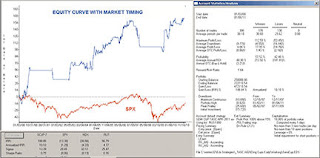I have prepared the AIQ code based on Giorgos Siligardos’ article in the April issue of Stocks & Commodities magazine, “Identifying Cup Formations Early.” (The code can be viewed at www.Traders.com.) I devised a trading system using the Russell 1000 list of stocks to test the semi-cup formation as an entry technique. The trading rules for the system are as follows:
Entering a long position:
* Using a daily time frame, enter a long position when a semi-cup formation is first detected.
* Enter the next bar at the open using a market order.
Exiting a long position:
* Use a trailing 25% exit, or
* Protect 100% of a 15% or greater profit.
* Exit the next bar at the open using a market order.
Short positions were not tested.
In Figure 9, I show the results of simulated trading on the Russell 1000 stocks, using the following parameters:
1. Maximum positions per day = 3
2. Maximum total positions allowed = 10
3. Choose weakest candidates using 32-bar Aiq relative strength
4. Size each position at 10% of total account equity recomputed every day.
Figure 9: AIQ SYSTEMS, SAMPLE RESULTS FOR semi-cup formation SYSTEM. Here, a sample trading system using 76 actively traded NASDAQ stocks tests the semi-cup formation as an entry technique. For the test period 1/3/2000 to 1/6/2011, the average annual return was 18.8%, with a maximum drawdown of 68.8% on 11/20/2008.
For the test period 1/3/2000 to 1/6/2011, the average annual return was 18.8% with a maximum drawdown of 68.8% on 11/20/2008. Although the return is reasonably good, the maximum drawdown is larger than most could tolerate. With this in mind, I added a very simple market timing technique that added the following rules:
1. Longs can only be entered when the S&P 500 is trading above its 200-day simple moving average for two or more consecutive days.
2. Exit all positions when the S&P 500 falls below its 200-day simple moving average for two or more consecutive days.
For the test period 1/3/2000 to 1/6/2011, the average annual return was 10.1% with a maximum drawdown of 25.6% on 7/17/09 (see Figure 10). The drawdown was significantly reduced by the addition of the simple market timing technique. Although the average annual return was also reduced, the Sharpe ratio increased from 0.47 to 0.75, indicating a less risky approach.
Figure 10: AIQ SYSTEMS, revised results with market timing added. For the refined semi-cup system, over the test period 1/3/2000 to 1/6/2011, the average annual return was 10.1% with a maximum drawdown of 25.6% on 7/17/09.
The AIQ code is available in an EDS file at http://aiqsystems.com/april2011cupandhandle.EDS
save the file to your /wintes32/EDS strategies folder
—Richard Denning
info@TradersEdgeSystems.com
for AIQ Systems



